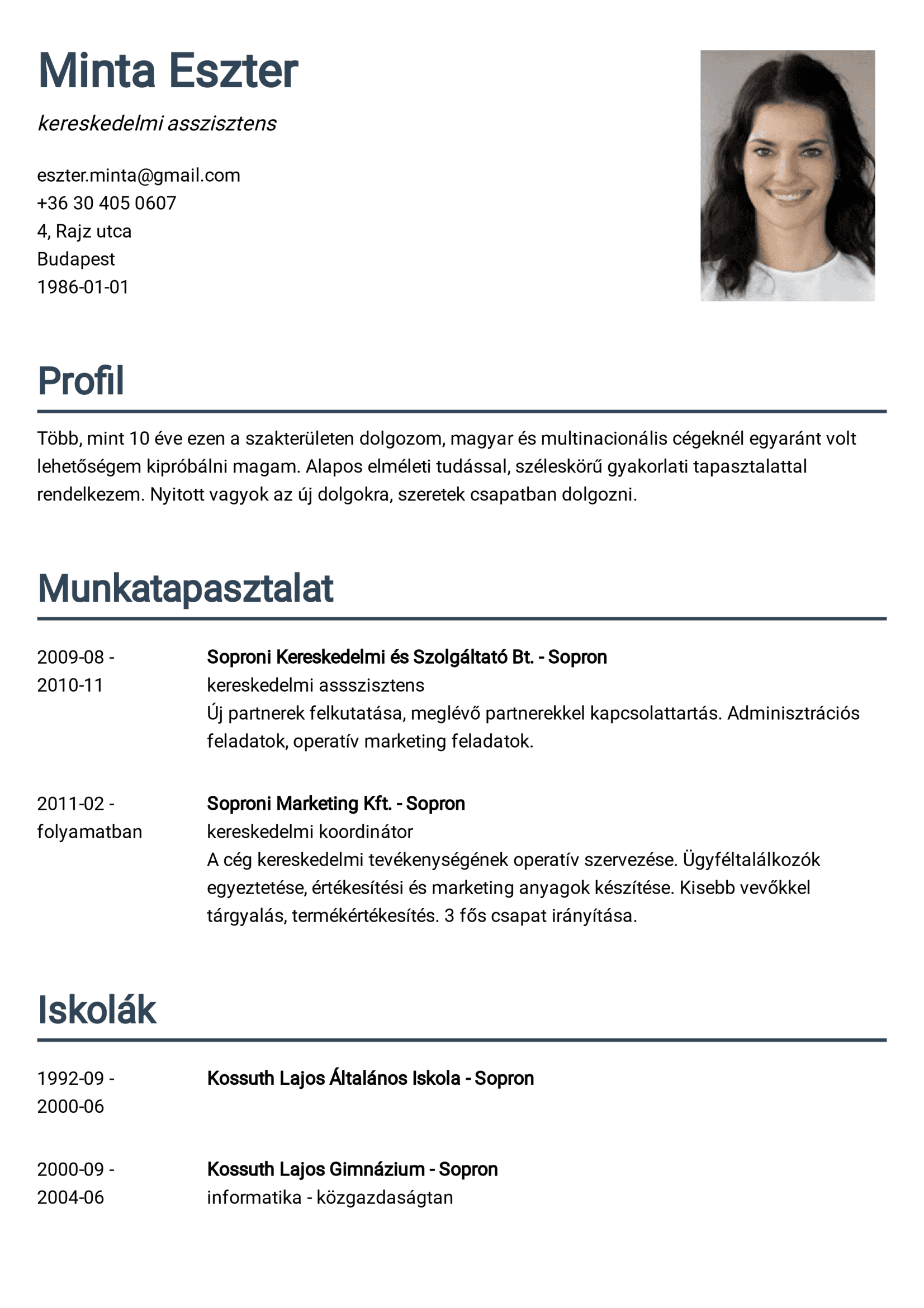

Traditional, Simple Resume
Nowadays, many people try to stand out from the crowd by applying with a complex resume that is as colorful, complex, and impressive as possible, bypassing the proven traditional resume templates. Is this a good strategy? No chance if you apply with a simple resume? In this article, we investigate this question. I'll tell you immediately that you make a good choice with a traditional, simple resume template, but you must pay attention to the detail
What is a simple resume template?
First, let's clear up a misconception: A traditional resume doesn't mean you write your biography in complete sentences. Although it was common 30-40 years ago for an applicant to write down the main stages of their life in a sentence-wise scribbled resume, today a, HR manager or decision-makers simply do not want to spend so much time reading and prefer to have the facts in a clear bullet-point format. The simple, traditional resume template is thus nothing other than a chronological resume! The strength of the simple resume template is that it focuses on the information. A good traditional resume contains the following information:
Contact details:
- Full name
- Address (optional)
- Phone number
- Email address
Short profile (optional) A brief summary of your person, highlighting your most important skills and experiences. This can immediately pique the interviewer's interest. Want to spice up your resume with a really meaningful introduction? Find all the important information in our article.
Objective (optional): You can make a good impression on the decision-maker by including the name of the position you're applying for in your resume. For example: "Market Manager." But make sure you update this field if you apply for another position! :)
Education: List your schools and degrees in chronological order. For each degree, state the degree's name, the course's duration, and the institution where it was obtained.
Work experience: List your jobs in chronological order. If you want to please HR managers and decision-makers, proceed in reverse chronological order, starting with your most recent experience. For each position, write the name of the employer, job title, location, start and end date, as well as the main tasks and achievements.
Skills: Mention specific skills and abilities that are of interest to the position you are applying for. For example, language skills, software knowledge, communication skills, etc.
Hobbies or interests (optional): Some personal interests or hobbies that show a different side of your personality. Find more information on how to include hobbies in your resume in our next article: Hobbies in the resume!
What other types of resumes are there?
To not make life too easy for applicants, there is a variety of resume templates 😊. Here are the most common examples:
Simple (chronological) resume: The traditional chronological resume presents education and work experience in chronological order. This type of resume is further described in detail below.
Functional resume: In this case, the focus is not on chronological order but skills and abilities. It highlights skills and achievements that are related to different jobs or projects.
Combined resume template: This type combines the features of chronological and functional resumes. In addition to chronological order, it also highlights relevant skills and achievements.
Targeted resume template: Here, the applicant focuses on a specific career goal or professional direction. The purpose of the resume and the required skills are emphasized.
Creative resume: These resumes often use an unusual format and creative elements to stand out from other applicants. They are often used by applicants in creative professions or for creative jobs.
Academic resume: Applicants applying for an academic or scientific career often use this type of resume to describe their studies, research experience, and publications.
Read more about the advantages and disadvantages of different resume templates in our article on this topic!
What are the advantages and disadvantages of a simple resume template?
Recruiters and managers prefer the simple resume template. Why this is the case and what the advantages and disadvantages of the traditional resume template are, we explain to you here:
Advantages
Easy to read and follow: A traditional chronological resume is easy to read because it chronologically presents your qualifications and work experiences, allowing readers to easily track your professional journey.
Transparency: A good traditional resume is very transparent, thanks to its structure.
Traditional and accepted: The chronological resume is the most widespread and accepted resume format.
Searchable by computer: If you apply to larger companies, your resume is often scanned by special software and sorted into its database structure. These software programs cannot scan all resumes equally well, but almost all do well with the traditional resume template!
Disadvantages
Emphasis on job changes: If you have changed jobs regularly or had frequent changes in your career, a chronological resume can highlight these changes and possibly put you in a negative light. Also, you might have been between two jobs for a few months. So, if you use a traditional resume template, it's important not to leave any "holes" in your resume! Fill these periods with at least one entry, "Active job search," or if you were in training or had to care for a family member during this time, enter that. Anything is better than an empty hole!
Does not emphasize your skills: This format does not highlight your skills and abilities but focuses on facts and your achievements.
Not suitable for career changes: If you are planning a career change where your previous work is not relevant to the new area, the traditional resume format can make it more difficult to show context and transferability to the new area.
Longer resume: If you have been working longer and had many jobs, a simple chronological resume can be longer, which is not always desirable, as employers usually prefer short and concise resumes. You can avoid this by not going into as much detail about your older jobs and, for example, not listing your areas of responsibility.
The advantages of a traditional chronological resume include transparency and acceptance, while the disadvantages include highlighting job changes and less emphasis on skills. However, the resume format you choose depends on your situation, the position you are applying for, and the industry's expectations.
What should you pay attention to when writing your traditional resume?
As we have written above, the traditional chronological resume is the best format to formally make an excellent first impression on HR managers. However, the content must be right to make a positive second impression. Here are some basic recommendations for writing your traditional resume:
Accurate information: Make sure your resume contains all relevant information, such as your name, contact details, qualifications, profession, and details of these professions. Your details must be accurate and up-to-date.
Keywords: Use keywords and phrases that match the job description and expectations of the industry. This can help your resume stand out in automated application systems. These keywords can include all areas you have worked in, all qualifications or training you have completed, and any work tools or software you have experience with.
Balance of length and content: Your resume should be short and concise but include all important information and experiences. You know the saying that a resume should not be longer than one page? I tell you this as the owner of a headhunting company: This is a misconception. If you need two pages describing your experiences and skills, don't cram them onto one page! 😊
No spelling or grammar errors: Always check your resume for spelling and grammar errors. Even have someone proofread it to ensure accuracy and professionalism.
Want to read more job search tips? In our blog, you will find articles written by HR professionals, such as our article on the 10 most common mistakes job seekers make!
How can you stand out from the crowd with a simple resume template?
A traditional chronological resume can stand out from the crowd if you apply a few practical tricks and strategies:
Striking title or summary: Use a meaningful title or introduction at the beginning of your resume, highlighting why you are a unique candidate for the position. An introduction can help pique the reader's interest immediately.
Highlighting achievements: Highlight notable accomplishments and successes in the job in your resume. For example, mention how much revenue you generated, which projects you led to success, or what improvements you made.
Technical and software skills: If you have technical or software skills relevant to the position, remember to list them.
Numbers and data: Use numbers and data in your resume wherever possible. For example, present the results of your projects in numbers or mention how many employees you managed in your team.
Recommendations or references: If you can, ask for references or recommendations from previous employers or colleagues. You can add these references to your resume or attach them as a separate document.
Customization: Always tailor your resume to the position you are applying for! This means highlighting the experiences and skills most important for the position you are applying for. Use the keywords and phrases mentioned in the job description.
If you apply these tricks, your simple resume will stand out from the crowd, and you can significantly increase your chances of getting an interview!







